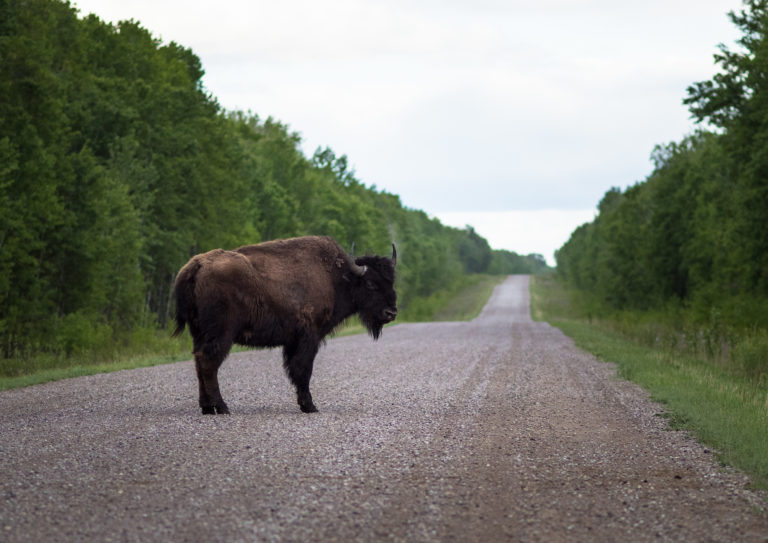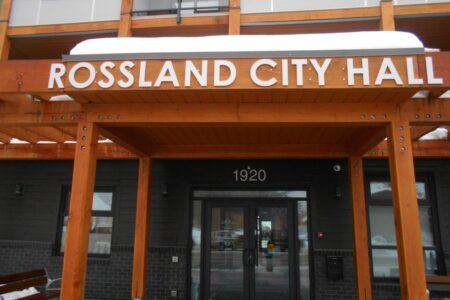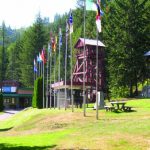Parks Canada shirks UN request for review of Site C dam impacts on imperilled national park
UNESCO issued a stern warning that, in order to keep Wood Buffalo National Park off a list of world heritage sites in danger, Canada must take “major and timely” action on 17 recommendations, including an impact assessment of B.C.’s controversial megadam
By Judith Lavoie, the Narwhal
Canada will not provide the UNESCO World Heritage Committee with an assessment of the impacts of the Site C dam on Wood Buffalo National Park, despite a recommendation it do so to keep the 4.5 million hectare park off a list of world heritage in danger — a list usually reserved for sites in countries facing war, poverty or disaster.
The clock is ticking towards a deadline for Canada to demonstrate to the committee that it is serious about saving Canada’s largest national park from energy development, dropping water levels and pollution.
The World Heritage Committee warned Wood Buffalo would be placed on the ignominious list unless there is a “major and timely” response to 17 recommendations made by the international body in 2017.
Canada has quietly release a draft action plan in response to those recommendations made by a team of experts from the World Heritage Committee and International Union for Conservation of Nature who, in 2016, visited the World Heritage Site at the invitation of the Mikisew Cree First Nation.
Canada’s action plan provides a response to all of the UN body’s recommendations, save one: a review of the social and environmental impacts of the Site C dam.
Wood Buffalo threatened by industrial development, hydro dams
Following a visit to the park in 2016, the committee released a stinging report saying Wood Buffalo is threatened by unfettered upstream energy development, including the Alberta oilsands, hydro dams on the Peace River, a lack of cumulative impact studies on the Peace-Athabasca delta and poor management.
Canada must finalize a plan to substantively address these threats to Wood Buffalo by February 1, 2019.
Key measures of Canada’s draft plan for the park in northern Alberta and southern Northwest Territories are strengthening Indigenous management of the site, preserving and monitoring ecosystems in the Peace-Athabasca delta and improving understanding of hydrology and water flow in the delta, Environment and Climate Change Minister Catherine McKenna said in a statement.
However, as the draft plan is being circulated among 11 Indigenous communities and other interested groups, many are baffled that the recommendation to assess the Site C dam is being ignored.
Recommendation 4 in the UNESCO report says that there should be “an environmental and social impact assessment” of the Site C dam and the effect of the controversial dam on the Outstanding Universal Value of Wood Buffalo National Park.
Failure to respond to that recommendation affects the validity of the plan according to some Indigenous communities, who witnessed dropping water levels in the Peace-Athabasca Delta after construction of the Bennett dam on the Peace River in 1968 and the Peace Canyon dam in 1980.
As the reservoir filled behind the Bennett dam, parts of the delta dried up and, according to residents of communities such as Fort Chipewyan, levels never again reached their former heights. Simultaneously, spring floods changed because the dams stopped the formation of ice jams that previously forced the water to back up into the delta.
Climate change and silting in the Peace-Athabasca delta are exacerbating man-made problems, meaning Indigenous families are often unable to reach traditional hunting grounds and winter supplies for communities such as Fort Chipewyan are restricted because of a shorter season for the ice road.
Now, those who live around the Peace-Athabasca delta and Wood Buffalo are looking with trepidation at construction of the Site C dam and asking why Parks Canada is not recommending a full assessment.
‘Nowhere else to turn’: First Nations inundated by oilsands projects face impossible choices
‘We need to have some action from Canada’
Becky Kostka, Smith’s Landing First Nation lands and resources coordinator, said Parks Canada is saying that the Site C joint federal-provincial environmental assessment is enough to protect the Peace-Athabasca delta.
“They have basically said ‘the assessment has been done on that. They have got their approvals and it’s going ahead,’ ” Kostka said.
“We are really not okay with that…We need to have some action from Canada on this.”
Kostka said her nation requested Parks Canada reconsider.
“They have refused,” she said.
Amy Lusk, Slave River Coalition coordinator, said the lack of an independent Site C assessment and cumulative impact study are major problems.
“They said the previous assessment from the joint review panel was sufficient,” she said.
The joint review panel released a report on Site C in 2014 in which it did not make a recommendation for or against the project, arguing the province had not demonstrated a need for the highly environmentally destructive project while also failing to explore alternatives.
During the federal-provincial review of the project, Parks Canada presented testimony to the panel indicating Site C would have a negative impact on the Peace-Athabasca delta.
Lusk said Parks Canada’s current decision to omit a new Site C impact assessment distorts the country’s entire response to UNESCO.
“The Site C recommendation and the calls for a cumulative impact study feed into everything else that’s touched upon,” she said.
“It’s not complete without that.”
Below: Map of threats to Wood Buffalo National Park from UNESCO report.
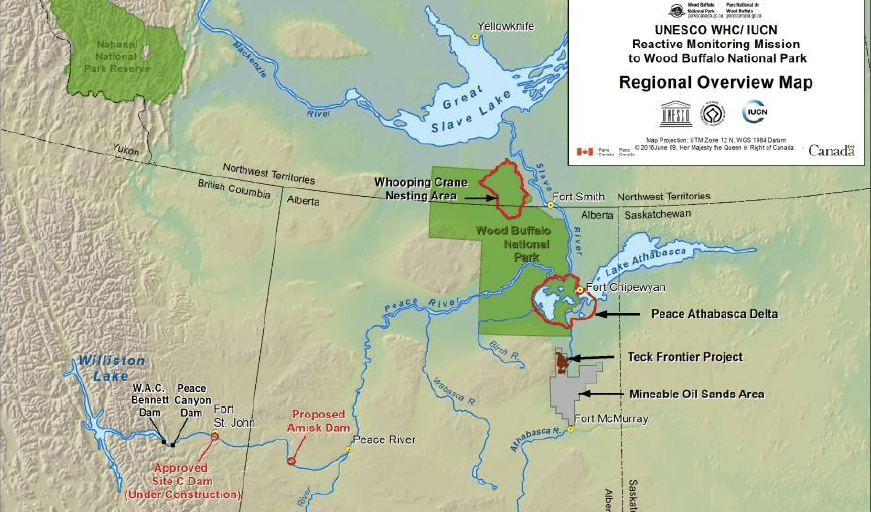
Parks Canada considering future mitigation measures
Parks Canada told The Narwhal the draft action plan sets out new initiatives related to environmental flows and hydrology which will increase understanding of the impacts of dams on the Peace River, including Site C.
In July the federal government announced it would spend $27.5 million over five years “to support the development of an action plan to secure the future of Wood Buffalo National Park World Heritage Site.” The figure amounts to approximately $125 per square kilometre of the park, an amount local communities criticized as insufficient.
The draft action plan also looks at options for future mitigation measures, a spokeswoman said via e-mail.
Site C was approved after a cooperative assessment by Canada and B.C. and the Canadian Environmental Assessment Agency has been conducting inspections of the project to ensure BC Hydro is in compliance, the spokeswoman added.
Many are not convinced that is sufficient.
In a letter and petition addressed to Parks Canada and carbon copied to environment minister McKenna and provincial politicians, Lusk argues the failure to respond to Recommendation 4 is a significant shortfall.
“By failing to meet this recommendation, Parks Canada undermines efforts to successfully address the threats to Wood Buffalo National Park. Water quality and quantity are the key underlying challenges to the other 16 recommendations identified,” says the letter, which was also distributed to the World Heritage Committee.
“If Canada fails to address the above concerns in the Action Plan, we will recommend Wood Buffalo National Park be added to the UNESCO list of World Heritage Sites in Danger,” the letter reads.
The Northwest Territories chapter of the Council of Canadians echoes many of the same concerns in an additional letter, where the organization says an environmental and social impact assessment of Site C is needed to try and mitigate negative impacts to the Peace-Athabasca delta and Wood Buffalo’s unique ecosystem.
“If impacts cannot be mitigated, the Site C project must be abandoned,” it says.
“Already, two-thirds of the drying of the Peace-Athabasca Delta, which supports Wood Buffalo’s unique ecosystem is the direct result of the existing dams on the Peace River. Site C will escalate drying in the delta,” the letter states.
“In addition, after flooding, decomposition processes will create poisonous methyl mercury which will bio-accumulate in the aquatic food chain, poisoning fish and those whose diet relies on fish for two or three generations. These effects will be experienced in the Peace-Athabasca Delta.”
‘The delta’s best chance’
Ron Yarworski, technical adviser to the Northwest Territory Metis Nation, said he believes attention must be put on the cumulative impacts of dams on the Peace River, the Bennett dam as well as Site C.
And, like others, Yarworski is pleased with some aspects of the draft plan, such as work on hydrology, including the possibility of building weirs and other infrastructure to retain water in the delta.
Below: The lower bare rocks of an island in Lake Athabasca indicate where the lake’s water mark used to be decades ago. Fort Chipewyan, Alberta, June 2018. Photo: Louis Bockner / Sierra Club BC
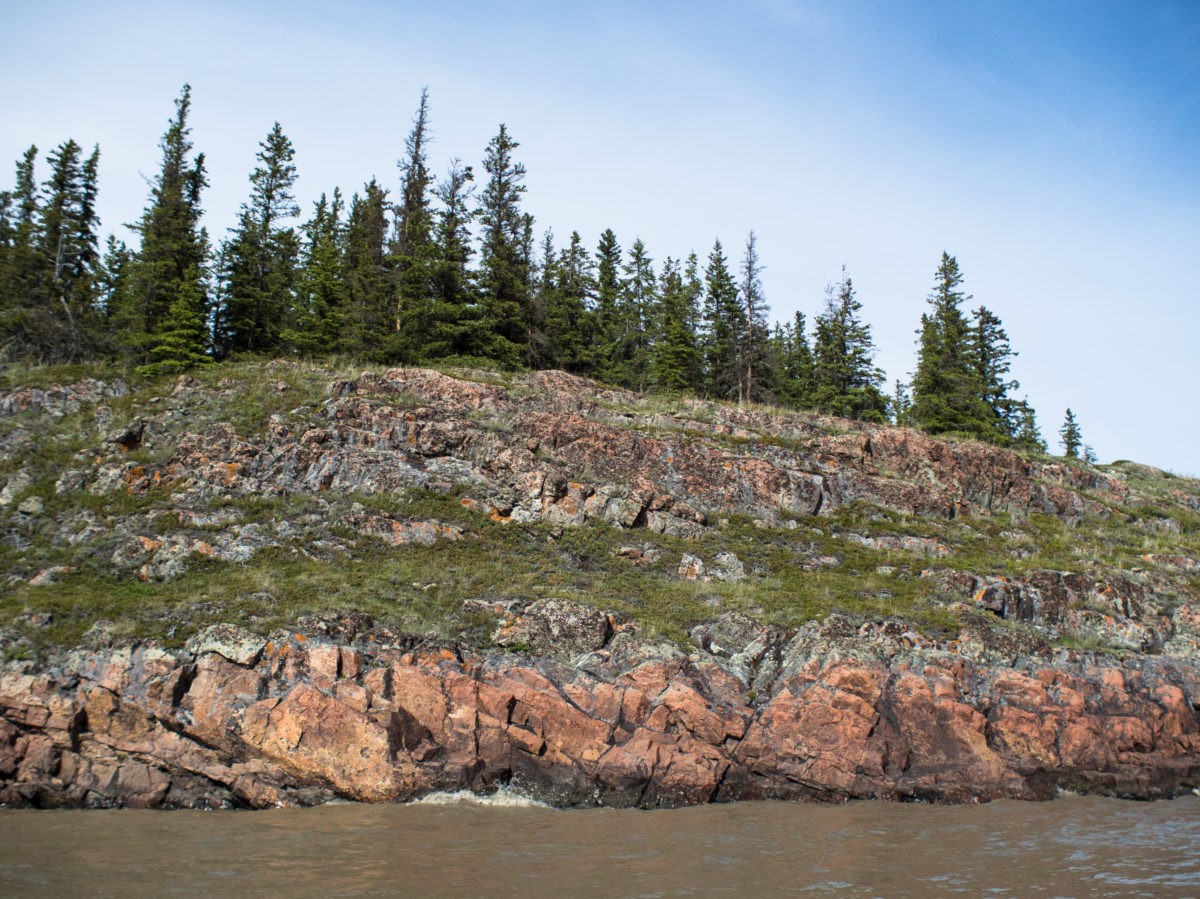
“But the proof will always be whether they are actually going to follow through and whether Canada is actually going to fund this,” Yarworski said.
“I think, if the action plan is implemented to the fullest, it’s the delta’s best chance in a while,” he said, adding that it is sad that it took an international spotlight on the park to get action.
“At least now we have something, so let’s hold everyone’s feet to the fire,” he said.
Parks Canada recently extended the timeframe for public feedback to December 14, 2018 after receiving criticism for not sufficiently publicizing the release of the draft plan, which is still not made public on Parks Canada’s website.
Lusk said it is disappointing that the review period is not being more widely promoted, even though Environment and Climate Change Minister Catherine McKenna said that she encourages “everyone to share their views on the future of Wood Buffalo National Park World Heritage Site.”
“I would see this as a failure,” Lusk said.
Action Plan Draft WBNP WHS Nov. 16 2018 by The Narwhal on Scribd


